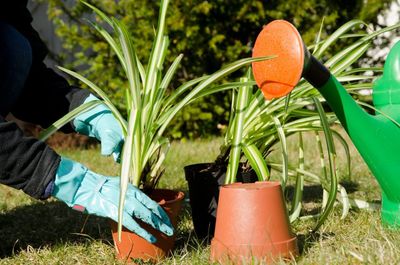How to Propagate Office Plants
There are several different methods of propagating plants in the office, and the best technique depends on the growth characteristics of the plant. Here are a few tips on propagating common office plants:
Division
Division is the simplest propagation technique, and works beautifully for plants that produce offsets. In general, the plant is removed from the pot and a small section, which must have several healthy roots, is gently separated from the main plant. The main plant is returned to the pot and the division is planted in its own container. Plants suitable for propagation via division include:
Peace lily Dumb cane Spider plant Kalanchoe Peperomia Aspidistra Oxalis Boston fern
Compound Layering
Compound layering allows you to propagate a new plant from a long vine or stem attached to the original (parent) plant. Although it tends to be slower than other techniques, layering is an extremely easy means of office plant propagation. Just select a long stem. Leave it attached to the parent plant and secure the stem to potting mix in a small pot, using a hairpin or bent paper clip. Snip the stem when the stem roots. Layering by this means is suitable for plants such as:
Ivy Pothos Philodendron Hoya Spider plant
Air layering is a somewhat more complex procedure that involves stripping the outer layer from a section of stem, then covering the stripped stem in damp sphagnum moss until roots develop. At that point, the stem is removed and planted in a separate pot. Air layering works well for:
Dracaena Diffenbachia Schefflera Rubber plant
Stem Cuttings
Office plant propagation via stem cutting involves taking a 4 to 6 inch (10-15 cm.) stem from a healthy plant. The stem is planted in a pot filled with moist potting soil. Rooting hormone often speeds rooting. Many plants benefit from a plastic covering to keep the environment around the cutting warm and moist until rooting takes place. In some cases, stem cuttings are rooted in water first. However, most plants root best when planted directly in potting mix. Stem cuttings work for a large number of plants including:
Jade plant Kalanchoe Pothos Rubber plant Wandering jew Hoya Arrowhead plant
Leaf Cuttings
Propagation via leaf cuttings involves planting leaves in moist potting mix, although the specific means of taking leaf cuttings depends on the particular plant. For example, the large leaves of snake plant (Sansevieria) can be cut into pieces for propagation, while African violet is easy to propagate by planting a leaf into the soil. Other plants suitable for leaf cuttings include:
Begonia Jade plant Christmas cactus
